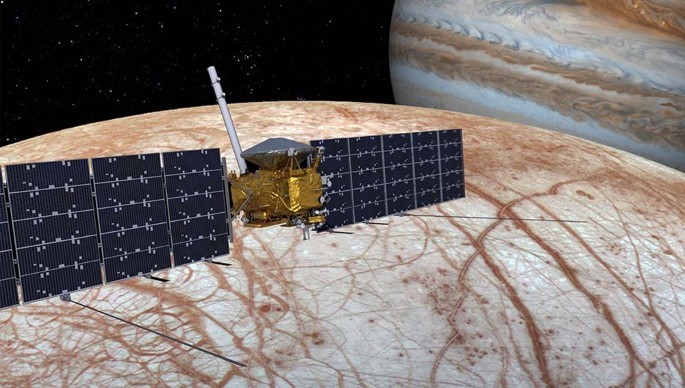
The main body for NASA’s Europa Clipper spacecraft was completed in June. It was quickly shipped to NASA’s Jet Propulsion Laboratory at Pasadena in California. Europa Clipper’s main body has arrived, marking a major step forward in spacecraft development. This means that the spacecraft is on schedule to launch in 2024.
“This is an exciting moment for all of the project team and a significant milestone.” “With this delivery and the Europa Clipper science experiment, we are one step closer to launch,” said Jordan Evans, Europa Clipper project manager from NASA’s Jet Propulsion Laboratory.
The spacecraft’s primary body has been completed but the overall construction of the craft is still not complete. There are many mission components that remain to be assembled and fitted on the spaceship.
Europa Clipper’s main frame arrived at JPL. It allows engineers and technicians access to the spacecraft’s construction. The work is expected to be complete within two years.
The Europa Clipper’s main body is made of aluminum and measures 3 m high by 1.5 m wide. The main body is also cylindrical. It already contains various electronics, radios as well as thermal loop tubing, cabling, and propulsion systems. These will be used throughout the mission’s 10-year duration at Jupiter.
Europa Clipper’s solar arrays will also be deployed. The spacecraft will measure the same size as a basketball court. It will be the largest planetary exploration mission NASA has ever built.
The main module is made up of two aluminum cylinders that are placed on top of one another. Each cylinder will be fitted with the instruments of Europa Clipper and other spacecraft components via threaded holes.
Europa Clipper’s radio frequency unit will power eight antennas. These antennas will be used for communication with Earth and other spacecraft. One of these antennas is the mission’s huge high-gain antenna. This antenna is three meters in width and will be used for data transfer between Jupiter and Earth.
Europa Clipper’s system of electrical cables and connectors is another system that is tied to the main body. The harness weighs just 68 kilos and contains nearly 640 meters’ worth of wires and connectors.
Europa Clipper’s electronics vault, which is heavy-duty and built to withstand the intense radiation of Jupiter and its moons, will house the mission’s most critical electronics. It will be integrated at JPL with the mission’s main modules and some of its science instruments.
The main module houses two tanks to hold the spacecraft’s fuel. The main module will house the fuel and the oxidizer in one tank. The main module also contains the tubing which transports gasoline from the tanks into the Europa Clipper’s 24 engines.
Tim Larson (JPL deputy project manager) explained that our engines have dual-purpose capabilities. “We use them for major maneuvers like approaching Jupiter and needing a huge burn to be trapped inside Jupiter’s orbit. They are also designed for minor movements such as controlling the spacecraft’s attitude or fine-tuning precise flybys to Europa and other solar systems worlds.
Europa Clipper’s primary body was developed and constructed in collaboration with JPL and Goddard Space Flight Center. The project was completed by the Johns Hopkins Applied Physics Laboratory, (APL), in Laurel.
What’s in store
After the main body has arrived at JPL, engineers will continue working on and preparing the main module for final testing.
Evans said, “What arrived at JPL represents an assembly stage essentially unto itself.” This delivery was completed under the leadership of APL and involves work from two NASA centers. JPL’s team will take the system even further into integration.
Europa Clipper will launch in October 2024. However, it is still being tested and constructed. After launching atop a SpaceX Falcon Heavy rocket, the spacecraft will travel to Jupiter for five-and-a-half years before inserting itself into orbit to begin its four-year science mission. Europa Clipper will fly nearly 50 passes of Europa during those four years.
Based on other observations, the evidence suggests that Europa may have an underground ocean. This ocean contains twice as many water molecules as Earth’s oceans. Furthermore, it is possible that the internal ocean might be suitable for life support.
Europa Clipper’s primary scientific objective is to verify and study this huge ocean.
Europa Clipper will transport nine science instruments to study Europa. These include the Europa Thermal Emission Imaging System for Europa (E-THEMIS), Mapping Imaging Spectrometer Europa (MISE), Europa Imaging System for Europa (EIS), Europa Ultraviolet Spectrograph Europa (Europa–UVS), Radar for Europa Assessment and Sounding Ocean to Near-surface: Ocean to Ocean (REASON), Radar for Europa Assessment & Sounding: Ocean and Near-surface (REASON), Radar for Magnetometry (PIMS), Mass Spectrometers for Planetary Exploration and the Surface Dust Anas (SUDA).
All these instruments will be studying Europa’s surface, atmosphere, and interior characteristics. This information can be used to determine the depth and salinity of the Europas ocean, its thickness and icy surface crust, and any potential plumes that may be ejecting water into space. It is similar to Enceladus at Saturn.
Europa Clipper’s instruments are almost complete. They have been shipped to JPL and assembled. Now they await integration onto their respective places on the spacecraft. This stage of development, also known as assembly, testing, and launch operations has been ongoing since March 2022.
Europa Clipper’s flight hardware will be almost complete by the end of 2022. They will then be shipped to JPL.





